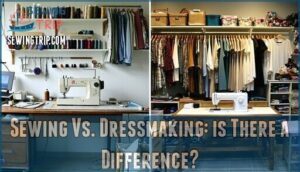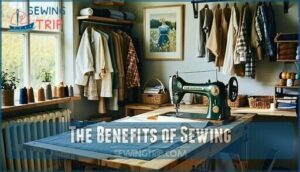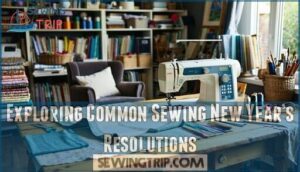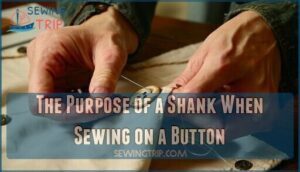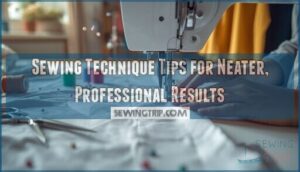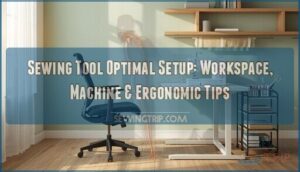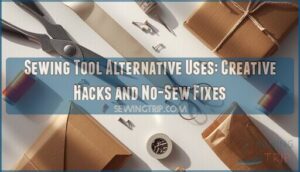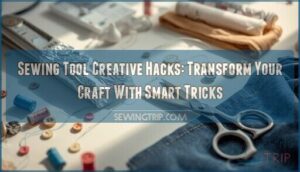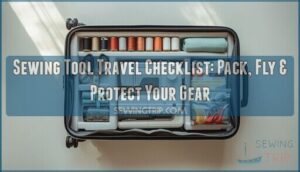This site is supported by our readers. We may earn a commission, at no cost to you, if you purchase through links.
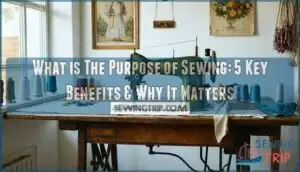
You’ll find it’s a practical skill for creating custom clothing that fits your body perfectly, repairing damaged garments instead of tossing them out, and personalizing items to reflect your unique style.
It’s also a creative outlet that boosts hand-eye coordination and provides stress relief through mindful, repetitive motions.
Plus, you’re doing the planet a favor by reducing textile waste.
Whether you’re hemming pants or crafting a masterpiece, sewing connects you to a tradition that spans centuries while giving you the power to create exactly what you envision.
The real magic happens when you discover just how therapeutic those first few stitches can be.
Table Of Contents
- Key Takeaways
- Benefits of Basic Sewing Skills
- Making Your Own Clothes: Why It Matters
- Sewing Vs. Dressmaking: is There a Difference?
- The Importance of Learning Dressmaking
- The Benefits of Sewing
- Exploring Common Sewing New Year’s Resolutions
- The Purpose of a Shank When Sewing on a Button
- Frequently Asked Questions (FAQs)
- Conclusion
Key Takeaways
- You’ll save money and reduce waste by repairing clothes instead of replacing them, while creating custom pieces that fit your body perfectly rather than settling for mass-produced options
- You’ll find genuine stress relief and therapeutic benefits through the mindful, repetitive motions of stitching that calm your mind and boost hand-eye coordination
- You’ll express your creativity and personal style by transforming ordinary fabric into unique garments that reflect your individual taste and vision
- You’ll develop a valuable life skill that connects you to sustainable fashion practices while building confidence through tangible accomplishments you can wear and share
Benefits of Basic Sewing Skills
You’ve discovered that sewing offers far more than just fixing torn clothes or hemming pants.
Learning basic sewing skills opens up a world of creative possibilities while delivering practical benefits that can transform both your wardrobe and your daily life, making it a skill with practical benefits.
A Unique Look
Through custom fit and personal style, you’ll create a unique wardrobe that perfectly reflects your fashion expression.
Sewing techniques let you design custom clothes that actually fit your body, not someone else’s measurements.
Your garment construction skills transform ordinary fabric into extraordinary pieces that showcase your individual taste and creative vision through thoughtful dressmaking.
Mastering various sewing machine techniques is essential to achieving professional-looking results and bringing your personal style to life with custom clothes.
Hand-Eye Coordination
Threading your needle becomes second nature as you develop precise hand-eye coordination through sewing practice.
Each stitch strengthens your motor control and fine motor skills, creating seamless harmony between your hands and eyes.
Here’s how sewing sharpens your coordination skills:
- Hand dexterity improves through repetitive stitching and needlework skills
- Eye focus develops as you align seams and follow intricate sewing techniques
- Motor control strengthens with consistent practice of various stitching patterns
Emotional Well-Being
Every stitch you make becomes a pathway to emotional balance and mental health improvement.
Every stitch weaves tranquility into your soul, creating peace one thread at a time.
Sewing transforms into your personal stress relief sanctuary, where needle and thread create therapeutic moments of pure mindfulness.
This meditative craft naturally calms racing thoughts while building self esteem through tangible accomplishments.
Experience these benefits:
- Mind-Body Connection: Sewing fosters harmony between your thoughts and actions, promoting mindfulness.
- Therapeutic Outlet: Engage in a stress-relieving activity that eases worries and calms the mind.
- Mood Enhancement: Witness your emotions stitch into your creations, uplifting your spirits.
Social Life Improvement
Sewing circles open doors to lifelong friendships and shared passions.
You’ll discover online groups buzzing with creativity, local community projects that need your skills, and sewing expos where connections flourish naturally.
These social connections transform your hobby into something bigger—a vibrant sewing community where skill sharing becomes second nature, and your sewing social life blossoms through meaningful online friendships.
| Connection Type | What You Gain | Why It Matters |
|---|---|---|
| Sewing Circles | Local friendships | Face-to-face support |
| Online Groups | Global inspiration | 24/7 community access |
| Sewing Expos | Industry connections | Professional growth |
Environmental Impact
Your fabric choices can make or break the planet’s future. When you choose sustainable fabrics and embrace upcycling clothes, you’re fighting textile waste head-on.
Every fabric choice you make is a vote for the planet’s future.
Every repair reduces consumption more than buying new. Ethical fashion isn’t just trendy—it’s necessary for environmental sustainability.
By learning to mend tears and reattach buttons, you’re practicing reduce reuse recycle principles daily. Ecofriendly fabrics paired with your growing skills create a powerful combination for sustainability that benefits both your wallet and Earth’s future.
Understanding Eco Friendly Fabrics is essential for making informed decisions about textile waste reduction.
Making Your Own Clothes: Why It Matters
Your closet’s potential transforms when you master clothing creation yourself.
You’ll discover the freedom of Custom Fit garments that flatter your unique body shape, something mass-produced clothing rarely achieves.
With handmade clothing, you’re not just following trends—you’re setting them through Personal Style choices that reflect who you truly are.
Sustainable Fashion becomes second nature as you select quality materials over disposable alternatives.
Your Fabric Choice decisions directly impact both durability and environmental responsibility.
Through garment construction, you’ll learn valuable Clothing Repair skills that extend your wardrobe’s lifespan substantially.
Fashion design principles guide your creative journey, while sewing patterns serve as your roadmap to success.
Each project strengthens your clothing creation abilities, building confidence with every finished piece.
You’re investing in a skill that pays dividends for life—both financially and creatively, with a focus on Sustainable Fashion and Unique Body Shape.
Sewing Vs. Dressmaking: is There a Difference?
Many people wonder if there’s actually a difference between sewing and dressmaking, and the answer might surprise you.
While both involve needle and thread, they’re distinct crafts with different goals and skill requirements.
Sewing is the broader umbrella term covering any fabric-joining technique.
You’ll use basic sewing techniques for repairs, crafts, quilting, and home décor projects.
It’s accessible to beginners and serves multiple practical purposes beyond clothing.
Dressmaking, however, is specialized garment construction focused exclusively on creating wearable clothing.
This craft demands advanced skills in pattern making, fabric selection, and tailoring basics.
Dressmakers master complex techniques like fitting, draping, and fashion design principles.
| Aspect | Sewing | Dressmaking |
|---|---|---|
| Scope | General fabric joining | Specialized garment creation |
| Skill Level | Beginner to advanced | Intermediate to advanced |
| Projects | Repairs, crafts, home textiles | Clothing and fashion items |
| Tools | Basic needles, thread, scissors | Dress forms, specialized machines |
| Focus | Functional or decorative | Fit, style, and wearability |
Understanding this distinction helps you choose the right path for your textile art journey.
The Importance of Learning Dressmaking
While basic sewing covers repairs and simple projects, dressmaking takes your skills to professional levels.
You’ll master Dressmaking Basics like Pattern Making and Garment Construction, transforming from someone who fixes hems to creating custom-fitted masterpieces.
Tailoring Techniques and smart Fabric Selection become your superpowers, letting you craft clothes that actually fit your body perfectly.
Sewing classes teach essential sewing patterns and fabric choice fundamentals, but dressmaking gives you creative freedom to design what you love wearing instead of settling for what’s available in stores.
Understanding Dressmaking Patterns is essential for creating custom garments that fit well and look great.
The Benefits of Sewing
Countless sewers discover that needle and thread open doors to both practical skills and personal transformation. Sewing therapy offers stress relief through repetitive motions that calm your mind, while fabric choice becomes your creative voice.
You’ll develop sewing self-confidence as projects come together, boosting sewing emotional wellbeing. Engaging in sewing activities can also promote crafting hobby benefits that enhance overall well-being.
Here are four key sewing benefits:
- Physical wellness – Improved hand-eye coordination and reduced blood pressure through meditative stitching
- Mental health – Sewing stress relief that decreases anxiety by 60% through focused concentration
- Environmental impact – Sustainable fashion choices through garment repair and upcycling old pieces
- Creative expression – Textile art that transforms ordinary materials into personalized masterpieces
Exploring Common Sewing New Year’s Resolutions
The journey toward sewing mastery starts with setting achievable sewing goals.
According to recent data, 80% of sewers target skill enhancement each New Year, while 45% focus on learning new techniques annually.
Your sewing resolutions should balance ambition with reality—whether you’re diving into pattern making or expanding your fabric choices.
Mastering various sewing projects can help you create unique gifts and improve your skills.
| Popular Sewing New Year’s Resolutions | Success Rate |
|---|---|
| Learning new techniques | 45% prioritize annually |
| Completing unfinished projects | 60% start year with incomplete work |
| Joining sewing communities | 55% plan community involvement |
| Sustainable sewing practices | 70% commit to reducing waste |
Smart sewing progress happens when you connect with your local sewing community.
Online tutorial engagement jumps 60% during January, proving you’re not alone in your creative projects ambitions.
Set specific targets like mastering one advanced stitch monthly or finishing those half-sewn garments collecting dust.
Remember, workshop enrollments surge 40% in January—you’ll find plenty of company on this stitching adventure.
The Purpose of a Shank When Sewing on a Button
When you’re sewing buttons, the shank isn’t just decoration—it’s your secret weapon for professional results.
This small protrusion creates space between the button and fabric, preventing puckering and ensuring smooth operation.
Without proper shank mechanics, your carefully crafted garments risk buttons that pull, tear, or pop off unexpectedly.
Smart thread selection and proper fastening methods depend on understanding shank function.
Whether you’re mastering basic sewing techniques or perfecting advanced button attachment skills, the shank transforms ordinary button sewing into durable, polished craftsmanship that stands the test of time.
Understanding shank button basics is essential for achieving secure and long-lasting button attachments.
Frequently Asked Questions (FAQs)
What is the point of sewing?
Thread by thread, you’re weaving freedom from fashion’s grip.
You’ll save money repairing clothes, express creativity through custom designs, reduce waste sustainably, and develop valuable skills that boost confidence.
You’ll also connect with like-minded communities.
What is the significance of sewing?
You’ll discover sewing transforms your relationship with clothing, offering creative freedom, money-saving repairs, and sustainable living. It’s therapeutic stress relief that builds confidence through handmade accomplishments.
What is the aim of sewing?
Studies reveal children’s hand-eye coordination improves 30% through needlework.
Your aim isn’t just stitching—you’re mastering precision, creativity, and self-reliance.
You’ll craft custom-fit garments, repair treasured pieces, and express your unique style while building confidence through every completed project, which helps in achieving self-reliance.
What is the purpose of sewing clothes?
You’re creating custom-fit clothing that reflects your unique style while saving money. It’s about transforming fabric into wearable art that perfectly suits your body and personal taste preferences.
What sewing tools do beginners need first?
You’ll need fabric scissors, measuring tape, seam ripper, pins, hand-sewing needles, and thread. A basic sewing machine comes next, followed by marking tools like fabric chalk or disappearing ink pens.
How long does learning basic sewing take?
Want to know the timeline? You’ll grasp basic hand-sewing techniques within 2-3 weeks of daily practice, while machine sewing fundamentals typically take 1-2 months to master comfortably.
What fabric types work best for beginners?
Cotton, linen, and cotton blends are your best friends when starting out. They’re forgiving, hold their shape well, and won’t slip away from you like silk does.
Can sewing machines replace hand sewing completely?
Machine mastery meets manual magic—while sewing machines streamline construction, you’ll still need hand-sewing skills for delicate details, repairs, and finishing touches that machines simply can’t replicate.
What common sewing mistakes should be avoided?
You’ll dodge frustrating setbacks by avoiding these rookie mistakes: skipping fabric pre-washing and rushing through pattern layout.
Using dull needles and ignoring seam allowances are other critical errors to avoid.
Forgetting to backstitch at seam beginnings and seam ends is also a common rookie mistake.
Conclusion
Like a thread weaving through generations, sewing connects you to countless possibilities and benefits.
Understanding what’s the purpose of sewing reveals it’s far more than a hobby—it’s a practical life skill, creative outlet, and therapeutic practice rolled into one.
You’ll save money, reduce waste, express your personality, and find genuine relaxation in every stitch.
Whether you’re mending a favorite shirt or crafting something entirely new, you’re embracing a timeless art that enriches both your wardrobe and well-being, allowing for creative outlet and genuine relaxation.
- https://www.cei.int/sites/default/files/2024-07/sewing-throughout-history.pdf
- https://www.sapiens.org/archaeology/fashion-history-sewing-needles/
- https://www.moodfabrics.com/blog/the-healthy-benefits-of-sewing/
- https://kers.ca.uky.edu/core/reports/Story/s/866
- https://www.sligococo.ie/Keepwell/ManagingYourMood/BenefitsofSewing/

